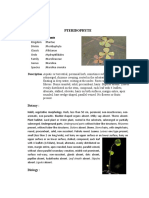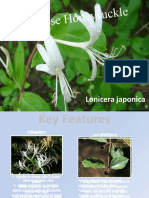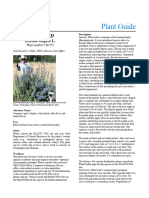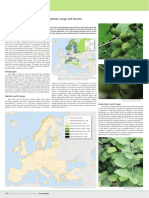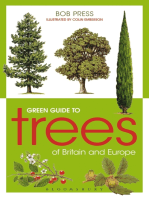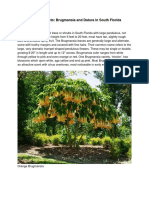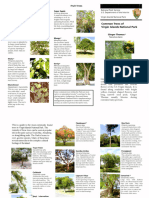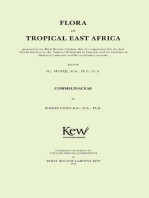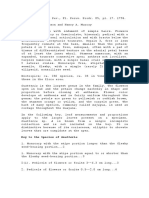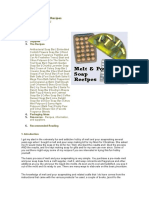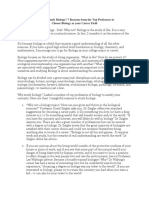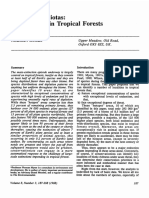Professional Documents
Culture Documents
Radula Complanata Lindenbergiana Voluta
Uploaded by
Florbela GraçaCopyright
Available Formats
Share this document
Did you find this document useful?
Is this content inappropriate?
Report this DocumentCopyright:
Available Formats
Radula Complanata Lindenbergiana Voluta
Uploaded by
Florbela GraçaCopyright:
Available Formats
Jungermanniales
Radula complanata/lindenbergiana/voluta
Even/Lindenberg’s/Pale Scalewort
Key 42
R. complanata
1 cm R. complanata 4 mm R. lindenbergiana
R. lindenbergiana
2 mm R. complanata 4 mm R. voluta
R. voluta
Identification Radula species have rounded, overlapping, bilobed leaves, with the smaller lobule
folded underneath. These three species have shoots up to about 3 mm wide, and
leaves up to about 1.5 mm long and wide. Plants are usually flattened, either forming
patches or scattered stems creeping among mosses. R. complanata is pale yellowish-
green, and up to 3 cm long. Rounded, sack-like male bracts can be seen with a hand
lens on the same shoots as the long, flat perianths. Leaf margins often (but not
always) have gemmae. R. complanata is by far the most common and widespread
Radula species. R. complanata is monoicous, whereas R. lindenbergiana is dioicous;
non-fertile plants of these two species cannot be identified to species. However,
pale, fertile plants with gemmae, but without sack-shaped male bracts below the
perianths are usually R. lindenbergiana. R. voluta is also pale, but has a larger lobule
which crosses the stem, and no gemmae.
Similar species R. aquilegia, R. carringtonii and R. holtii (p. 203) are usually brownish-green or grey-
green, and are smaller (shoots 1–2.5 mm wide, and leaves less than 1.5 mm long and
wide), and hardly ever have gemmae. R. holtii is sometimes pale green, but always
much smaller (shoots up to 1.8 mm wide). Radula species differ from Scapania and
Diplophyllum species (pp. 166–167) in having the smaller lobule underneath and
differ from Porella (pp. 206–210), Lejeunea (pp. 221–223) and Frullania species
(pp. 211–215) in having no underleaves.
Habitat R. complanata normally occurs on trees and shrubs anywhere except the highest
mountains. It avoids deep shade, but likes sheltered, moist conditions. It also occurs
on rocks by streams, lake margins and sea cliffs, when it is darker and usually non-
fertile. R. lindenbergiana is more common in upland areas, usually on rocks. R. voluta
grows on shaded, damp rocks, especially near waterfalls.
202 Photos Gordon Rothero (top left), David Holyoak (bottom left) & John Birks (right) Text John O’Reilly
You might also like
- Sorbus AriaDocument2 pagesSorbus AriaNVAzirNo ratings yet
- Polygonaceae, The Buckwheat FamilyDocument102 pagesPolygonaceae, The Buckwheat FamilyLavinia BarbuNo ratings yet
- Aquatic Plant IdentifierDocument6 pagesAquatic Plant IdentifiernitecapNo ratings yet
- Common Ferns of Florida - E. Revuelta 2016bDocument38 pagesCommon Ferns of Florida - E. Revuelta 2016bAllan EPNo ratings yet
- Marsilea Crenata: PteridophyteDocument9 pagesMarsilea Crenata: PteridophyteNur Rezki OctaviaNo ratings yet
- Scientific All NameDocument5 pagesScientific All Nameleo AñascoNo ratings yet
- Sorbus AucupariaDocument2 pagesSorbus AucupariaNVAzirNo ratings yet
- Oxalis Del PERUDocument290 pagesOxalis Del PERUpanchofrancoNo ratings yet
- Keanekaragaman Hayati: 1. Amaranthus SPDocument7 pagesKeanekaragaman Hayati: 1. Amaranthus SPMalLaNo ratings yet
- Eriobotrya Deflexa - Bronze LoquatDocument3 pagesEriobotrya Deflexa - Bronze LoquatEfisioNo ratings yet
- Sea Stats - MangrovesDocument4 pagesSea Stats - MangrovesFlorida Fish and Wildlife Conservation CommissionNo ratings yet
- Crepe Myrtles: For Central FloridaDocument2 pagesCrepe Myrtles: For Central Floridaeab7686No ratings yet
- Hibiscus Syriacus Rose-of-Sharon: Fact Sheet ST-295Document4 pagesHibiscus Syriacus Rose-of-Sharon: Fact Sheet ST-295loverboy105No ratings yet
- Walking Tour PDFDocument8 pagesWalking Tour PDFavubnaNo ratings yet
- Japanese H Oneysuckle: Lonicera JaponicaDocument6 pagesJapanese H Oneysuckle: Lonicera Japonicashannon_abbyNo ratings yet
- Invasive Flora of the West Coast: British Columbia and the Pacific NorthwestFrom EverandInvasive Flora of the West Coast: British Columbia and the Pacific NorthwestNo ratings yet
- Common Trees: Dr. H. SantapauDocument10 pagesCommon Trees: Dr. H. SantapauSwarnima TripathiNo ratings yet
- Berry Identification SheetDocument3 pagesBerry Identification Sheetritsondigby80No ratings yet
- Mayeth B. VillanuevaDocument4 pagesMayeth B. VillanuevaMayeth VillanuevaNo ratings yet
- Panicum Capillare Adalah Spesies Tumbuhan Yang Tergolong Ke Dalam Famili Poaceae. SpesiesDocument4 pagesPanicum Capillare Adalah Spesies Tumbuhan Yang Tergolong Ke Dalam Famili Poaceae. Spesiesroy gunawanNo ratings yet
- Laboratory Report TemplateDocument5 pagesLaboratory Report TemplateCedrick Bacuaja InutaoNo ratings yet
- Tree and Shrub BookletDocument61 pagesTree and Shrub BookletGodFather xNo ratings yet
- Syringa Reticulata Japanese Tree Lilac: Fact Sheet ST-610Document4 pagesSyringa Reticulata Japanese Tree Lilac: Fact Sheet ST-610Alain RatataNo ratings yet
- PG EcvuDocument4 pagesPG Ecvuamiralak255No ratings yet
- Kinds of LichensDocument4 pagesKinds of LichensRovic MelladoNo ratings yet
- Alnus Incana: Alnus Incana in Europe: Distribution, Habitat, Usage and ThreatsDocument2 pagesAlnus Incana: Alnus Incana in Europe: Distribution, Habitat, Usage and ThreatsGeorge UngureanuNo ratings yet
- Snake WeedDocument3 pagesSnake WeedUssi AffilaterNo ratings yet
- Common Buckthorn Glossy Buckthorn: (Rhamnus Cathartica) (Frangula Alnus)Document6 pagesCommon Buckthorn Glossy Buckthorn: (Rhamnus Cathartica) (Frangula Alnus)Len BenschopNo ratings yet
- Acer PlatanoidesDocument4 pagesAcer PlatanoidesnamkvalNo ratings yet
- Moss ChartDocument7 pagesMoss ChartSamela SelimovicNo ratings yet
- Summer Wildflowers 2000Document2 pagesSummer Wildflowers 2000lahadslfnsdkNo ratings yet
- HaldinaDocument2 pagesHaldinaAngel AngelNo ratings yet
- Key To Potentillas of ColoradoDocument7 pagesKey To Potentillas of ColoradoColorado Native Plant SocietyNo ratings yet
- Green Cities Steward Plant Guide2Document38 pagesGreen Cities Steward Plant Guide2AxyNo ratings yet
- Aster of ChicagoDocument4 pagesAster of ChicagoCarlos MontoyaNo ratings yet
- Chi AloeDocument1 pageChi AloeNhânNo ratings yet
- Evergreens by ZoneDocument4 pagesEvergreens by ZonejhNo ratings yet
- Shrubs PDFDocument10 pagesShrubs PDFHadie Manc UtdNo ratings yet
- Endemic Plants & Animals in The PhilippinesDocument8 pagesEndemic Plants & Animals in The Philippinespatricia de roxas67% (3)
- Cryptomeria JaponicaDocument5 pagesCryptomeria JaponicaFitzgerald BillyNo ratings yet
- Poison Ivy: Toxicodendron Radicans (L.) KuntzeDocument2 pagesPoison Ivy: Toxicodendron Radicans (L.) Kuntzeapi-24805498No ratings yet
- Weed and Forage Diseases ControlDocument26 pagesWeed and Forage Diseases ControlJonathan Aycardo FestinNo ratings yet
- Zornia LatifoliaDocument4 pagesZornia LatifoliasunnyNo ratings yet
- Desert Magazine 1983 DecemberDocument40 pagesDesert Magazine 1983 Decemberdm1937100% (2)
- Aronia: Native Shrubs With Untapped Potential Mark BrandDocument12 pagesAronia: Native Shrubs With Untapped Potential Mark BrandpunciNo ratings yet
- GardeningDocument35 pagesGardeningMegha ShivarajNo ratings yet
- Angel Trumpets - Brugmansia and Datura in South FloridaDocument6 pagesAngel Trumpets - Brugmansia and Datura in South FloridaQueremosabarrabás A BarrabásNo ratings yet
- HortiDocument11 pagesHortibhaveshNo ratings yet
- Weed Identification GuideDocument1 pageWeed Identification GuideAnonymous i71HvPXNo ratings yet
- VIIS Tree GuideAccessibleDocument2 pagesVIIS Tree GuideAccessibleKerry Josephs-ThomasNo ratings yet
- Tree and Shrub Identification Made Simple: by Alice BrandonDocument25 pagesTree and Shrub Identification Made Simple: by Alice BrandonlmnNo ratings yet
- Peyote IdentificationDocument10 pagesPeyote IdentificationDennis Panayotis Ostrensky SaridakisNo ratings yet
- Buckthorn-Fact SheetDocument2 pagesBuckthorn-Fact SheetAmandaNo ratings yet
- Clave de Especies Del Genero GuatteriaDocument10 pagesClave de Especies Del Genero GuatteriaAnonymous ek4z9UBNo ratings yet
- Flora EuropaeaDocument1,344 pagesFlora EuropaeaokrimUb67% (3)
- Water & Glue... Who Knew?: Technology Workshop Living Food Play OutsideDocument13 pagesWater & Glue... Who Knew?: Technology Workshop Living Food Play OutsideFlorbela GraçaNo ratings yet
- All Natural Carrot Soap Recipe With Real Carrots - Lovely GreensDocument9 pagesAll Natural Carrot Soap Recipe With Real Carrots - Lovely GreensFlorbela GraçaNo ratings yet
- Formula Base Sabao NaturalDocument1 pageFormula Base Sabao NaturalFlorbela GraçaNo ratings yet
- 2012 JFPP Prof. Ana CristinaTeresaDocument6 pages2012 JFPP Prof. Ana CristinaTeresaFlorbela GraçaNo ratings yet
- Making Creams From Natural IngredientsDocument8 pagesMaking Creams From Natural IngredientsFlorbela Graça100% (1)
- Melt and Pour Soap RecipesDocument19 pagesMelt and Pour Soap RecipesFlorbela Graça50% (2)
- Male and Female AnimalsDocument7 pagesMale and Female AnimalsMayur VaghelaNo ratings yet
- Herbarium Jurusan Ipa Terpadu Fmipa-Unnes Kampus Sekaran Gunungpati 50229 Semarang, IndonesiaDocument3 pagesHerbarium Jurusan Ipa Terpadu Fmipa-Unnes Kampus Sekaran Gunungpati 50229 Semarang, IndonesiaShailaNo ratings yet
- 7 Reasons To Study BiologyDocument3 pages7 Reasons To Study BiologyRhelbamNo ratings yet
- Evolution by Stages of Wild CabbageDocument10 pagesEvolution by Stages of Wild CabbageAdish NairNo ratings yet
- Parts of A Plant - PowerPointDocument35 pagesParts of A Plant - PowerPointTeacher JAY-AR LAGMANNo ratings yet
- Ecology Study GuideDocument5 pagesEcology Study GuideJack TalleyNo ratings yet
- Biotecnología Reproductiva en Animales Silvestres Reproductive Biotechnology in Wild AnimalsDocument15 pagesBiotecnología Reproductiva en Animales Silvestres Reproductive Biotechnology in Wild AnimalsDany BautistaNo ratings yet
- Biological ClassificationDocument5 pagesBiological Classificationshubhamchopra97No ratings yet
- The Role of Microorganisms in Bioremediation-A ReviewDocument9 pagesThe Role of Microorganisms in Bioremediation-A ReviewKashmeera Geethanjali AnirudhanNo ratings yet
- Lab 2 Poster NewDocument3 pagesLab 2 Poster NewAfina AnuariNo ratings yet
- 003 143 Scottishbeavertrialfinalreport Dec2014 1417710135 PDFDocument176 pages003 143 Scottishbeavertrialfinalreport Dec2014 1417710135 PDFQuốc BìnhNo ratings yet
- Lodhi GadernDocument13 pagesLodhi GadernPOONAMNo ratings yet
- B.tech Biotechnology Admission Brochure CompressedDocument4 pagesB.tech Biotechnology Admission Brochure CompressedAmiruddin RafiudeenNo ratings yet
- Strange But True Animals Reading ComprehensionDocument4 pagesStrange But True Animals Reading ComprehensionOmar Bel MamounNo ratings yet
- Morphology of MushroomDocument11 pagesMorphology of MushroomTushar JadhavNo ratings yet
- Integrated Management of Pests: Dr. Mahesha H B, Yuvaraja's College, University of Mysore, MysuruDocument5 pagesIntegrated Management of Pests: Dr. Mahesha H B, Yuvaraja's College, University of Mysore, Mysuruvandv printsNo ratings yet
- Threatened Biotas Hotspots in Tropical ForestDocument22 pagesThreatened Biotas Hotspots in Tropical ForestRayam David Sandes BurgosNo ratings yet
- Wildlife Protection Act-Restrictions and Prohibitions On HuntingDocument14 pagesWildlife Protection Act-Restrictions and Prohibitions On HuntingDashang DoshiNo ratings yet
- Lesson Plan in Science 3Document3 pagesLesson Plan in Science 3jaymeNo ratings yet
- Biology SS1 Third Term ExamDocument2 pagesBiology SS1 Third Term ExamEBIWONJUMI KOLAWOLE AMOS100% (2)
- Bibliography Cell ModelDocument3 pagesBibliography Cell Modelapi-310910225No ratings yet
- Matching Headings 2Document3 pagesMatching Headings 2Eplus AcademyNo ratings yet
- Entomology 171208103504 PDFDocument23 pagesEntomology 171208103504 PDFAce Gerson GamboaNo ratings yet
- Spoliazeylanica01nati PDFDocument182 pagesSpoliazeylanica01nati PDFBaraNo ratings yet
- Perbedaan Respon Seleksi, Kemajuan Seleksi, Dan Jumlah Segregan Transgresif Hasil Persilangan Tomat Suka Naungan Dengan Tomat Peka NaunganDocument7 pagesPerbedaan Respon Seleksi, Kemajuan Seleksi, Dan Jumlah Segregan Transgresif Hasil Persilangan Tomat Suka Naungan Dengan Tomat Peka NaunganSABRINA WIEN KUSMUTAFMINo ratings yet
- Gene MappingDocument13 pagesGene MappingNishat FatimaNo ratings yet
- Forest Ecosystem 2014 PreboardDocument12 pagesForest Ecosystem 2014 PreboardDear PrudenceNo ratings yet
- Body SymmetryDocument1 pageBody SymmetryCyanDesNo ratings yet
- Economic Importance of Bacteria and FungiDocument14 pagesEconomic Importance of Bacteria and FungiRonnith NandyNo ratings yet
- ExtinctionDocument5 pagesExtinctionKhairul ShahmiNo ratings yet




